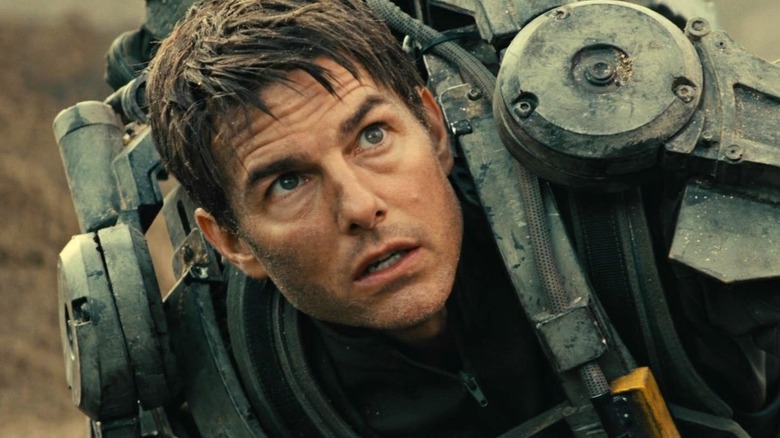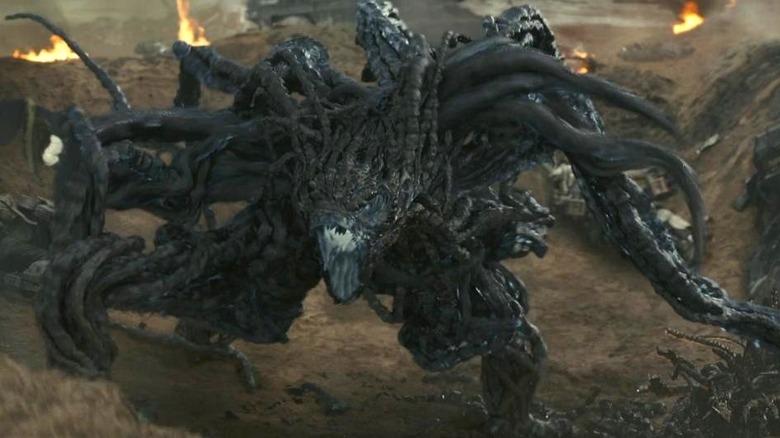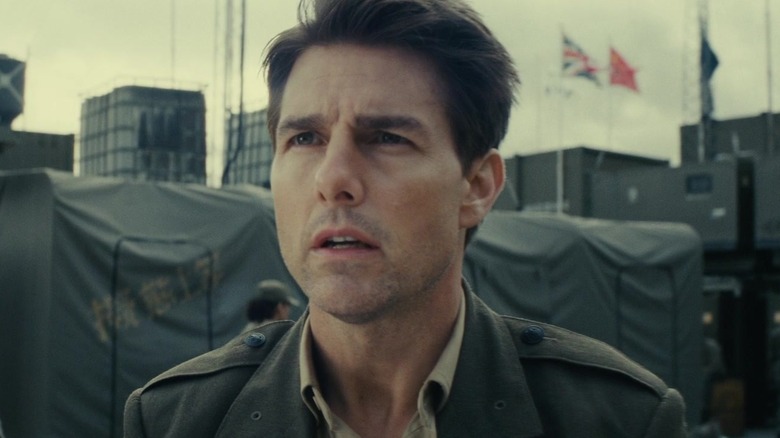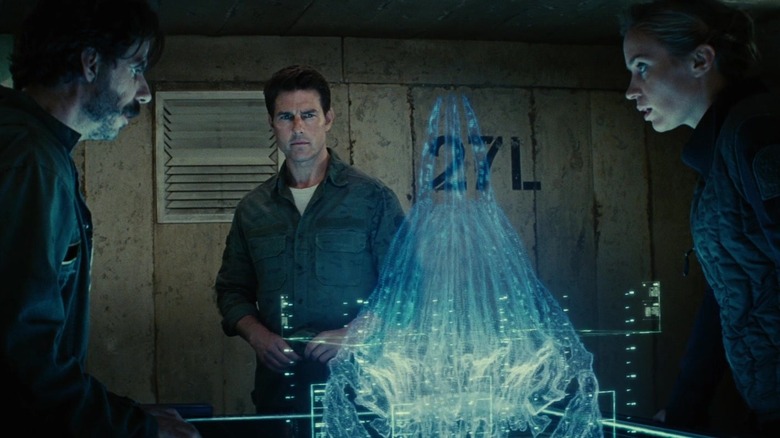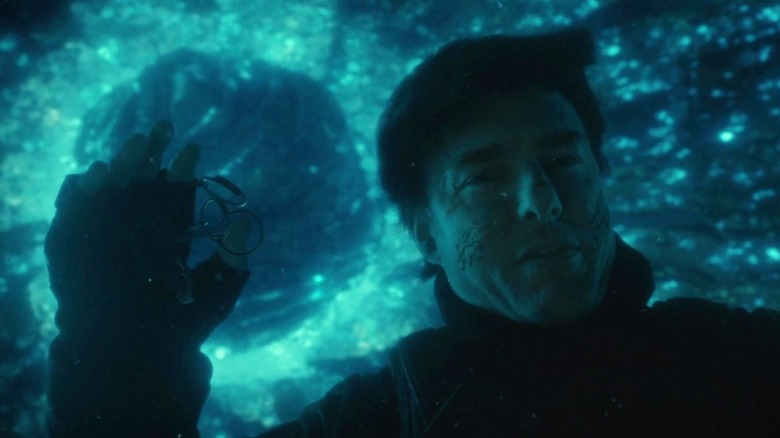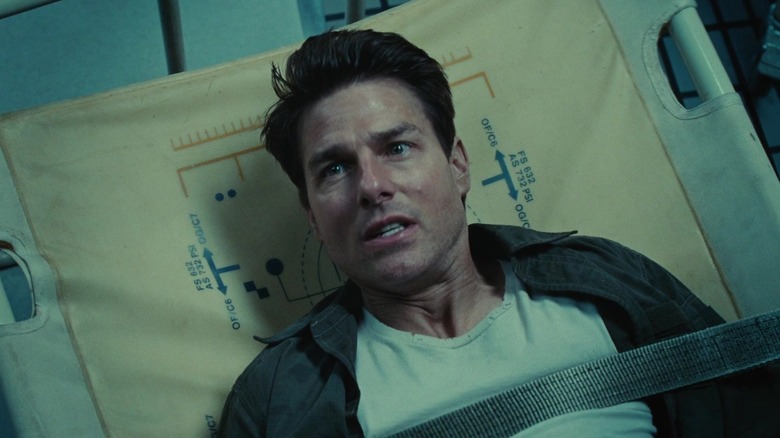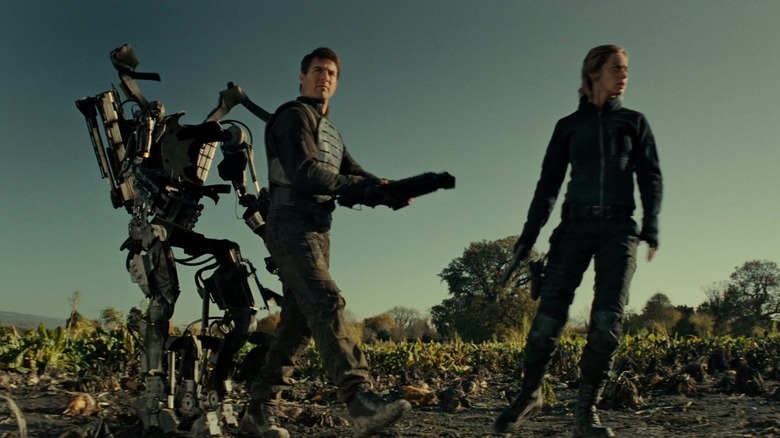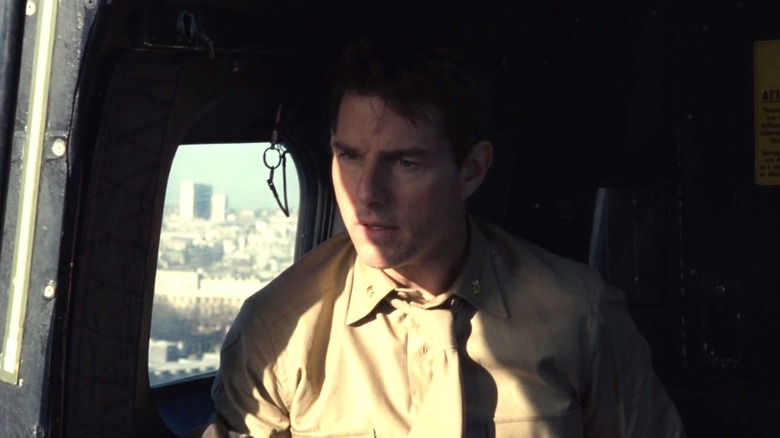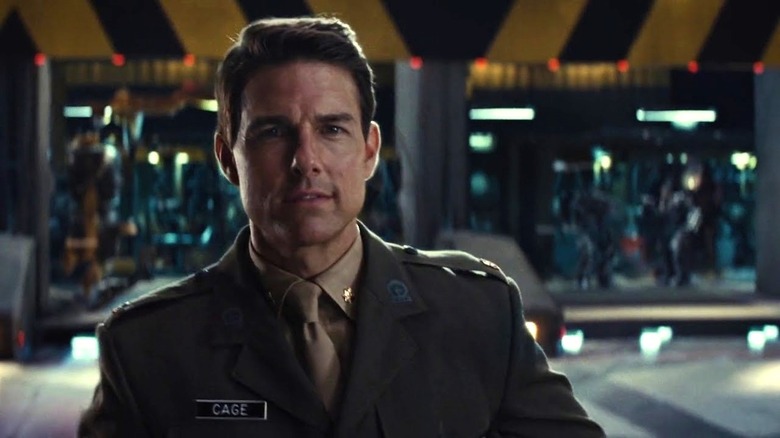Edge Of Tomorrow Ending, Explained
We may receive a commission on purchases made from links.
One of the best sci-fi movies of the last decade, "Edge of Tomorrow" (aka "Live, Die, Repeat") hit theaters in 2014, starring Tom Cruise and Emily Blunt, and while the film is a highly enjoyable mixture of pulse-pounding action, satisfying character development, and time loop-y antics, it also can be a little confusing.
Featuring a "Groundhog Day"-like premise — in which United Defense Force media relations manager William Cage (Cruise) finds himself reliving the same horrific day over and over, aided by the only other person who's ever experienced this before, Rita Vrataski (Blunt) — "Edge of Tomorrow" sings a familiar tune, but it can sometimes be a little difficult to follow all the lyrics. As a result, it's not unusual to finish the movie with a few lingering questions. The answers are there, but much like Cage's repeating day, it may take a few passes to figure out what's going on. Fortunately, we've re-lived this rewatchable sci-fi film a few times and feel well-equipped to help you navigate through its twisty ending.
How do the Mimics' time-travel abilities work in Edge of Tomorrow?
Understanding the ending of "Edge of Tomorrow" requires you to have been paying pretty close attention toward the beginning, because what exactly the extraterrestrial Mimics are doing gets explained pretty early on, and it goes by fast. As explained by Dr. Carter (Noah Taylor), a Mimic biologist, the Mimics are really like one giant, interconnected organism, with larger "Alpha" Mimics acting as the central nervous system and commanding the Mimic drones. These high-ranking Alphas then return information to be processed by the central "Omega" Mimic. However, each time an Alpha dies, the Omega rolls the clock back 24 hours, keeping all of their collective knowledge intact and enabling the Mimics to adjust their strategies in order to gain a definitive victory.
While the Alphas seem to be the decision makers of the Mimics, dictating the actions of the drones and determining their strategy, Carter hypothesizes that since the Omega essentially functions as the brain of the Mimics, the only way to stop the Mimic invasion is to destroy it. The problem is that thanks to their powers, the Mimics know about the military's biggest weakness, and they have a lot more experience than Cage and Vrataski in utilizing their time loop abilities to their advantage, so they're pretty adept at keeping the Omega safe and hidden.
What happened to Rita at Verdun?
There's a whole juicy prequel just waiting to be made in the story of Rita Vrataski at the Battle of Verdun, which we hear about in bits and pieces but never see. From what we learn at the beginning of the film, the human battle against the Mimics dragged on for five years before the United Defense Force (UDF) finally gained their first victory at Verdun, led by Sergeant Vrataski, who was later nicknamed "the Angel of Verdun." The popular version of the story is that Rita led the UDF troops to victory due to her abilities as an exceptional soldier, but the truth is, she had another advantage that no one knew about: She was living in a time loop.
The first time Vrataski fought the Battle of Verdun, she was killed. But similar to what would later happen to Cage in France, when Rita died, she also managed to take an Alpha with her, and their blood mingled together as they both kicked the bucket. So instead of staying dead, Rita woke up a day before Verdun, and she lived out that battle over and over, gaining a bit more ground each time before she died. After many repetitions, Rita started experiencing visions of the Omega, and she attempted to follow them in order to destroy the brain and defeat the Mimics once and for all. But in the course of finally leading the UDF to victory over the Mimics, she was badly injured and received a blood transfusion. Without the Mimic blood, she lost both the looping ability and the visions.
Why did the day start resetting for Cage?
The first time Cage was dropped into the middle of the battle in France, he had absolutely no idea what he was doing. He didn't even know how to turn off the safety on his gun. Yet he still managed to outlast most of the other members of his unit through sheer luck. However, Cage eventually wound up alone and on his back, surrounded by Mimics, including a giant, blue-tinged Alpha. In desperation, Cage grabbed for a UDF incendiary device lying beside him on the ground and fired it off right as the Alpha lunged for him.
Unfortunately — and fortunately — for Cage, while the resulting explosion was powerful enough to blow up the Alpha, it killed him as well. As Cage lay dying, his flesh burning away, the blood of the dying Alpha dripped into his open wounds, passing along its link to the Omega and giving Cage the same ability the Alphas have — when he dies, the day is reset, so he can learn from his previous actions and improve upon them next time. As with the Alphas, his consciousness was knocked back 24 hours in time. Since the invasion had taken place in the morning, he woke up on the preceding morning, when he first arrived at Heathrow military base.
Why did Cage think the Omega was in Germany?
Once Cage and Vrataski start working together, Rita preps Cage for what to expect: He'll keep looping over and over, and eventually, he'll start experiencing visions of the Omega. When that happens, the two of them can use Cage's visions to locate the Omega and destroy it. According to Vrataski and Carter, although the humans won at the Battle of Verdun, it was really a loss overall, because it caused Rita to lose the time loop ability before she could find the Omega and end the war. So Cage's main goal now that he has the ability isn't to help the UDF claim a victory at the invasion of France but to locate and eliminate the Omega once and for all. Based on Vrataski and Carter's research, that's the only way to end the Mimic threat once and for all.
When Cage's visions do eventually start, he's able to use architectural clues to narrow the Omega's location to a dam in Germany. Cage and Vrataski spend the next many loops attempting to get from the beach in France to the dam in Germany, but once Cage finally reaches his destination, he's horrified to realize that the Omega isn't there after all. It turns out that his visions (and likely Rita's as well) weren't a glimpse into the Omega's consciousness but rather a carefully laid trap, in which they saw exactly what — and where — the Omega wanted them to see.
What were the Mimics trying to do with the visions?
When Cage shows up at the dam in Germany in search of the Omega, he's instead greeted by an Alpha and a drone, with the Omega nowhere to be found. While previous Mimics have killed Cage the instant they get a chance, these Mimics seem to have something else in mind. Instead of ripping him apart as usual, the Alpha merely wounds Cage, giving him a deep gash that bleeds profusely. As Cage watches his blood drip out of his body, he surmises that this is the Mimics' true plan, to lure him away from his allies and then steal back the power kept in his blood.
How exactly the Mimics were planning to take the power from Cage is never made entirely clear. After all, Cage has bled many times before as he died, and that's never caused him to lose the ability. So whether they were planning to somehow drain him of all his blood or whether the Mimics had another way to extract the power, we'll never fully know. What is clear is that the visions were never an advantage over the Mimics, but instead, they were consciously created by them in order to lead Cage and Vrataski into a trap. Perhaps each time one of the looping humans died, it deepened the link with the Omega, until the Omega was finally able to plant thoughts in their minds and manipulate their actions. In that case, Vrataski losing the ability at the Battle of Verdun may not have been the setback she thought it was and may have actually worked in her favor.
Where was the Omega actually located?
Although the visions of the dam in Germany proved to be a red herring, the Omega was still hunkered down in Europe, just in a different country. After Cage and Vrataski stopped relying on his visions to lead them where they needed to go, they managed to locate the Omega through a different method, using the direct link between the Omega and the Alphas (and, similarly, Cage) to pinpoint its location.
Ultimately, the real Omega is located deep beneath the Louvre Pyramid in Paris, France. When Cage, Vrataski, and the rogue J-Squad arrive at the famous museum, the area is flooded by the Seine River, with the Omega located underwater. Typically, the Pyramid serves as the entrance to the museum, housing an expansive lobby underneath, but in "Edge of Tomorrow," this entire area is in disarray following the Mimic attacks on Paris and the overflowing of the Seine. So while normally there's no water underneath the Louvre Pyramid, in "Edge of Tomorrow," Cage has to swim the final distance down to the Omega.
What was the device that Cage got from General Brigham?
After realizing that the visions are not, in fact, a roadmap to the Mimics' greatest weakness (and in hindsight, why would they be?), Cage and Vrataski are forced to re-evaluate their strategy to destroy the Omega, and they decide instead to resort to a piece of technology Carter started developing back when Rita was the one caught in the loop, which he hoped would lead them to the Omega. Carter was never able to complete this transponder, since Vrataski lost the ability to loop before they could test it on her, and Carter subsequently lost his job and had his research confiscated by the UDF.
After getting fired, it appeared that Carter tried making a new transponder, but he told Vrataski it didn't work, possibly because of his lack of resources following his demotion or because he didn't have a subject with a link to the Alphas to test it on. So instead, they had to acquire Carter's original device, which was kept in a safe in General Brigham's (Brendan Gleeson) office. While the mechanics of the transponder are left a bit fuzzy, it works by making contact with the blood of an Alpha, through which it establishes a link to the Omega and determines the creature's location. Since Cage's blood has the same properties as that of an Alpha, Vrataski was able to use the transponder on Cage, which is how they determine that the Omega is under the Louvre.
Why didn't Cage want a blood transfusion?
According to Vrataski, the only rule Cage must abide by while he loops is that if he gets injured, he has to make sure he dies. She tells him that the way she lost the looping ability was through a blood transfusion, causing her to conclude that blood is the key to the ability. Many times throughout the film, Vrataski is in fact the one to kill Cage when he becomes injured, ensuring that he resets.
It's never clear exactly how much blood Cage could afford to lose while still holding onto his ability to reset. Based on his other injuries throughout the film, he could definitely spare at least a little blood without risking his link with the Omega, and it's unlikely that a transfusion would've replaced every drop of his blood. So it seems most likely that while some of Cage's blood did in fact remain in his body, the transfusion diluted it to the point where the Mimic link was severed.
How did Cage defeat the Mimics?
After receiving a blood transfusion following his theft of Dr. Carter's transponder from General Brigham's office, Cage and Vrataski realize they're all out of resets. That evening is their very last chance to find the Omega and prevent the UDF invasion in France, which is a trap set by the Mimics that will result in absolute defeat for the humans and the loss of countless lives. Knowing they won't get another shot at this, they enlist the help of J-Squad, who helps Cage and Vrataski steal a UDF plane.
They fly to Paris, where the area around the Louvre is completely overrun with Mimics, and all of J-Squad winds up sacrificing themselves in their quest to get Cage and Vrataski inside. Once they've finally made it in, Vrataski offers to provide a distraction that will allow Cage to cover the remaining distance to the Omega, knowing that neither one of them has any hope of making it out alive. As an Alpha kills Vrataski, Cage is able to get to the edge of the water covering the Omega and begins to swim down to it, holding a belt of grenades. The Alpha follows him and stabs him through the chest, but before Cage dies, he pulls the pins of the grenades and drops them down to the Omega, which dies in the explosion.
As the Omega dies, it attempts to restart the day again, similar to what it does when an Alpha dies. But it would seem that the Omega can't reset itself, and instead of giving the Mimics a do-over, it instead transmits its own death back 24 hours, killing all of the Mimics a day before the Omega itself was killed.
Cage said he lost the ability to reset ... so why did he reset at the end?
Throughout the whole movie, Cage and Vrataski firmly believe that if Cage ever receives a blood transfusion, he'll lose his reset ability for good, which is why they always ensure that he dies each time they don't complete their goal. So when he and Rita get into a car accident following their theft of the transponder from Brigham's office and Cage is given blood, they both assume they're literally on their last life. That's why they pull in J Squad — they want the best possible shot at accomplishing their mission, because it's the only chance they have left.
But then ... Cage resets after all! Apparently, after reaching the Omega and getting skewered by the Alpha, Cage held onto life just long enough to get bathed in the Omega and the Alpha's blood when the grenades went off, giving him the ability all over again. Having that blood in his system when he died meant that when the Omega attempted to reset the day, Cage got reset, too. However, unlike the Mimics, whose survival was tied to the Omega, Cage is a human, and his life doesn't depend on the Omega being alive. So while the Omega's attempted reset resulted in the deaths of all the Mimics 24 hours prior, Cage wasn't affected by the Omega's death and merely got another do-over he hadn't been expecting.
Why did Cage reset to a different point in Edge of Tomorrow's ending?
By the end of "Edge of Tomorrow," we've seen Cage reset dozens of times, always at Heathrow military base on the morning before the invasion in France. But at the end of the film, Cage wakes up in a helicopter on his way to his meeting with Brigham, before he was ever sent to Heathrow and, thankfully, before Rita or any of the members of J-Squad were killed. The different reset point can be confusing for "Edge of Tomorrow" audiences after watching Cage always return to the same time previously, but it makes sense as long as you understand that Cage lost the reset ability before the end and then regained it.
See, the first time Cage died, he reset to the day before that initial death, placing him at Heathrow the morning before the invasion on the beach. Think of that point in time at Heathrow kind of like a video game save point. Every subsequent time that Tom Cruise's character died, no matter how much time passed between him waking up and that particular death, he always reverted to that original save point. However, to extend the video game analogy, when he lost the reset ability, it was basically game over. The second time he gained the Mimic ability, he had to spin up a new game, which established its own unique save point, a day before he killed the Omega. Since the Omega died in the early hours of the morning before the France invasion, Cage reset to the previous morning, right before he met with Brigham.
Does Cage still have the reset ability at the end of Edge of Tomorrow?
It would be easy to finish "Edge of Tomorrow" wondering if Cage still has the ability to reset again if he died since that's what he does after defeating the Omega. Of course, without the Mimics to fight, Cage hopefully wouldn't find himself facing down death every day, but it could still be a handy ability to have in case he were to, for example, accidentally get himself run over by another truck. Granted, it would be a bummer for Cage to keep living for many years, die, and then wake up back en route to Brigham's office again, but one could argue that it might be preferable to staying dead.
However, there's actually no need to speculate about whether Cage's power is more of a blessing or a curse, since chances are, by the end of the film, he doesn't have it anymore. The way that Dr. Carter explains the Mimics' ability to Cage is that when an Alpha dies, the Omega resets it back to the day before. The Alpha isn't actually resetting itself, and it seems to have no special abilities without the guidance of the Omega. Since Cage essentially stepped into the role of an Alpha when he died, the time looping isn't actually his power. It belongs to the Omega. Without an Omega around to fling Cage's consciousness back in time whenever he dies, Cage is fated to live and die — with no repeat — just like the rest of us.
"Edge of Tomorrow" is available for rent or purchase on Prime Video.
